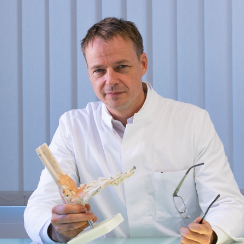The diagnosis of hallux valgus affects about 10 million people in Germany. Not all of them have a bump on their big toe that is so large or painful that it needs to be operated on. But if an operation is unavoidable, many sufferers ask themselves the question: How is hallux valgus operated on? In any case, you should only entrust yourself to a designated foot surgeon who can demonstrate many years of surgical experience in the correction of hallux valgus.
Why does hallux valgus surgery occur?
Why can an operation be necessary if the big toe is crooked or if there is a bump on the big toe? It is often the case that the so-called bunion develops over years. What is initially a small bump on the big toe grows over time and becomes larger. The causes can be very different, e.g.
- genetic predispositions
- Foot malpositions,
- Foot instabilities,
- Connective tissue weaknesses,
- Shoes that are too tight and too small
A combination of different causes can also favourably influence the growth of the big toe bump. Often, the growth of the bunion is accompanied by a crooked position of the big toe, which in turn can have an unfavourable influence on the position of the little toes. The growth of the bunion often causes pain - not least because the shoes pinch or the bump, the big toe or even the forefoot hurt. As a result, recurrent bursitis develops. Pain can also occur when the foot is at rest.
When should you see a foot surgeon?
Go early as soon as you discover the bump on the foot or the big toe is crooked. At the latest when the first pressure sets in and foot or toe pain is present, a visit to the foot surgeon is unavoidable. Often, conservative methods such as a splint, insoles or regular foot exercises can be used to counteract the pain. In the early stages, surgery is usually not necessary.
A foot surgeon with many years of experience and specialisation in the WHOLE foot should examine you thoroughly. The holistic approach is particularly important to find out the cause. A foot surgeon not only looks at your feet and your gait, he also takes a close look at your posture and body statics. A foot podium, an examination podium with an integrated podoscope, is also helpful.
Is your hallux valgus pain very frequent or already chronic because the bump on the big toe is very large and the big toe is already in a massive crooked position? Have you had repeated bursitis? Do you also have pain in the ball of your big toe or in the forefoot when you are not moving? Then hallux valgus surgery may be the right solution for you. In the following sections you will learn how a hallux valgus is operated on.
Learn more about Tonio Gottlieb, MD
How is hallux valgus operated on? The surgical procedures
How exactly is a crooked big toe with a bunion operated on? The foot surgeon chooses the surgical procedure depending on the stage of the hallux valgus. It depends,
- how severe the curvature of the big toe is,
- how far the foot and the small toes as a whole are misaligned,
- what the underlying cause of the hallux valgus is,
- what entitlement the patient has,
- which follow-up treatment is suitable for the patient.
The severity of the hallux valgus and the instability of the toes and foot are decisive in the choice of surgical procedure. As a rule, the correction is cause-oriented and sustainable, so that a recurrence of hallux valgus or other foot and small toe deformities can be avoided.
Surgical procedure:
Depending on which procedure is used, the aftercare and healing time will vary. Here you can find out more about the procedure for the individual surgical methods for a hallux valgus operation.
Combination of several surgical techniques for hallux valgus and other small toe deformities
Depending on the complexity of the foot malposition, the above-mentioned hallux valgus surgical procedures can be combined. In addition, a small toe malposition can also be corrected together with the hallux valgus malposition:
For example, if the middle toes are also affected,
- e.g., due to a hammer toe or claw toe deformity
- or due to a digitus superductus (complex malposition of the forefoot).
An attempt is then made to correct these malpositions in one operation and various surgical procedures and techniques are combined.
After a thorough examination and diagnosis, your foot surgeon will recommend the most suitable course of treatment for you with the appropriate surgical procedure. Ultimately, however, there is no specific "standard procedure" for a particular deformity; the individual case must always be considered and an individual approach chosen.
The minimally invasive surgical technique (MIS) for hallux valgus
In recent years, another surgical method has developed, the so-called MIS (minimally invasive surgery) of a hallux valgus deformity. This means that the bone is corrected via a small access point on the big toe and at the same time the bump on the big toe is removed. The bones are hardly or minimally fixed after the operation, and the patient can put weight on the foot again immediately after the operation.
Tonio Gottlieb, MD, advises:
„Please inform yourself comprehensively before deciding on a minimally invasive or causative surgical technique to correct a hallux valgus. There are advantages and disadvantages that need to be considered and should be taken into account depending on the individual case and the patient's requirements. To make a confident decision, I recommend seeking a second opinion from a designated foot surgeon.”



